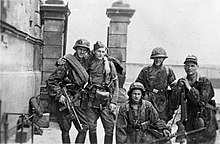Prelude to the Warsaw Uprising
| Warsaw Uprising |
|---|
 |
|
The Warsaw Uprising occurred at a stage of the Second World War when it was becoming clear that Nazi Germany was likely to lose. The Uprising ended in capitulation, the deaths of over 250,000 civilians, and only 15% of Warsaw intact; with the benefit of hindsight, many people have argued that it should never have been started. Others have argued that it was inevitable and even crucial for Poland to prove its commitment to the Allied cause. Although Stalin was later to describe it as a "criminal enterprise", just two days prior to its initiation, Radio Moscow had called for the Polish people to rise in arms.[citation needed]
Research in the circumstances that led up to the initiation of the Uprising is difficult because the facts are not always fully available: there are still some sources of information, such as the British and Soviet archives, which remain closed as of 2004[update]. Therefore, analysis of the Uprising must also incorporate the speculation, past and present, concerning the time prior to the uprising.
Operation Tempest
From the very beginning of its existence the
However, by 1943 it became apparent that the allied invasion of Europe would not come in time, and that in all probability the
Polish-Soviet relations were broken off on April 25, 1943, due to the Katyn massacre, and it became obvious that the advancing Red Army might not come to Poland as a liberator but rather, as General Rowecki put it, "Our Allies' Ally". On November 26, 1943, the Polish government in exile issued an instruction to the effect that if diplomatic relations with the Soviet Union were not resumed before their entry to Poland, the Home Army forces were to remain underground until further decisions were made. However, the Home Army commander took a different approach, and on November 30, 1943, the final version of the plan was created. It became known as Operation Tempest.[1]
Diplomacy with the Soviets and other Allies
This section needs expansion. You can help by adding to it. (May 2008) |
The Warsaw Uprising, or at least some form of
The Soviet advance
The plan was intended both as a political manifestation of the influence of Polish Government in Exile and as a direct operation against German occupiers. The fear was that in the aftermath of the war the allies would ignore the legal London-based government. It was clear that Poland would be liberated by the Red Army, and that the Soviet Union did not recognise the Government-in-Exile.
Initially, after the Red Army forces crossed the pre-war Polish borders, the local
Nevertheless, the Soviet advance was fast, and the Polish authorities saw no other choice but to continue the struggle against the German forces and aid the Soviets. At the same time the government in London asked the
The official line of Soviet propaganda was that the Polish underground was "waiting with their arms at ease" and was not fighting the common enemy. As the Soviet forces were nearing Warsaw in June and July 1944, the Soviet radio stations demanded a full national uprising in Warsaw to cut the communication lines of the German units still on the right bank of the Vistula. On July 29, 1944, the first Soviet armoured units reached the outskirts of Warsaw.
With the recent flood of reports from the eastern territories about forced demilitarisation, trials and execution of Home Army soldiers by the Soviets, on 21 July 1944 the High Command of the Home Army decided to expand the scope of the Operation Tempest to include Warsaw itself.[citation needed] The date for the Warsaw Uprising was set to 1 August. The uprising began at the end of the Soviet offensive Operation Bagration.
German defensive preparations
By the end of July the town had been declared "
On July 27, governor of the General Government Hans Frank called for 100,000 Polish men between the ages of 17–65 to arrive at several assembly points in Warsaw the following day. They were to be employed at construction of fortifications for the Wehrmacht in and around the city. This move was viewed by the Home Army as an attempt to neutralise the underground forces and the underground urged Warsaw inhabitants to ignore it. Fearing German reprisal actions, general Tadeusz Bór-Komorowski ordered full mobilisation of Home Army forces in Warsaw area.[3]
See also
References
- ISBN 978-1-349-09910-8, retrieved 2023-02-03
- ^ "Prelude to the Warsaw Uprising: Operation Tempest". The National WWII Museum | New Orleans. Retrieved 2023-02-03.
- ^ Winston S Churchill, The Second World War, Vol. 6, Chapter IX, The Martyrdom of Warsaw, 1955, Cassel
